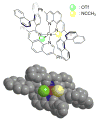Iron-catalyzed asymmetric epoxidation of β,β-disubstituted enones
- PMID: 21553923
- PMCID: PMC3116448
- DOI: 10.1021/ja201873d
Iron-catalyzed asymmetric epoxidation of β,β-disubstituted enones
Abstract
The combination of Fe(OTf)(2) and novel phenanthroline ligands enables the catalytic asymmetric epoxidation of acyclic β,β-disubstituted enones, which have been a heretofore inaccessible substrate class. The reaction provides highly enantioenriched α,β-epoxyketones (up to 92% ee) that can be further converted to functionalized β-ketoaldehydes with an all-carbon quaternary center.
Figures




References
-
-
For recent reviews on the asymmetric epoxidation, see: Adolfsson H, Shi Y. In: Modern Oxidation Methods. Backvall JE, editor. Wiley-VCH; Weinheim: 2004. p. 21.Matsumoto K, Katsuki T. In: Catalytic Asymmetric Synthesis. 3. Ojima I, editor. Wiley-VCH; New York: 2010. p. 839.Lane BS, Burgess K. Chem Rev. 2003;103:2457.Díez D, Núñez MG, Antón AB, García P, Moro RF, Garrido NM, Marcos IS, Basabe P, Urones JG. Curr Org Synth. 2008;5:186.Matsumoto K, Sawada Y, Katsuki T. Pure Appl Chem. 2008;80:1071.Wong OA, Shi Y. Chem Rev. 2008;108:3958.
-
-
-
For reviews on iron catalysis, see: Enthaler S, Junge K, Beller M. Angew Chem Int Ed. 2008;47:3317.Bolm C, Legros J, Le Paih J, Zani L. Chem Rev. 2004;104:6217.
-
-
-
For the seminal work on non-heme iron-catalyzed epoxidation: White MC, Doyle AG, Jacobsen EN. J Am Chem Soc. 2001;123:7194.
-
-
-
For examples of non-heme iron-catalyzed asymmetric epoxidation, see: Francis MB, Jacobsen EN. Angew Chem Int Ed. 1999;38:937.Marchi-Delapierre C, Jorge-Robin A, Thibon A, Ménage S. Chem Commun. 2007:1166.Gelalcha F, Bitterlich B, Anilkumar G, Tse M, Beller M. Angew Chem Int Ed. 2007;46:7293.Gelalcha F, Anilkumar G, Tse M, Brückner A, Beller M. Chem Eur J. 2008;16:7687.Yeung HL, Sham KC, Tsang CS, Lau TC, Kwong HL. Chem Commun. 2008:3801.
-
-
- Costas M, Mehn MP, Jensen MP, Que L. Chem Rev. 2004;104:939. - PubMed
Publication types
MeSH terms
Substances
Grants and funding
LinkOut - more resources
Full Text Sources
Medical

